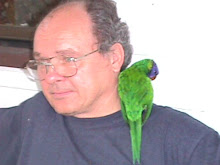Image available at species.wikimedia.org/wiki/Eurystomus_orientalis

The Dollarbirds Eurystomus orientalis appear to have gone. They came, they courted [entertained] in mid-air aerobatic displays, they nested, fledged young and have now gone on to fresher pastures. We expect them to return around October.
That, I suppose, is one advantage of having your own Backyard or Local Patch List, eventually you become quite familiar with those species that are either resident throughout the year or are regular seasonal visitors. At Allen Road the Laughing Kookaburra Dacelo novaeguinea [a kingfisher], Rainbow Lorikeet Trichoglossus haematodus, Noisy Miner Manorina melanocephala and Blue-faced Honeyeater Entomyzon cyanotis are typical of species slotting comfortably into the former category. Emblematic of our summer migrants are the Scared Kingfisher Todiramphus sanctus, Channel-billed Cuckoo Scythrops novaehollandiae and of course the Dollarbird.
It can go further. If one keeps records than extend beyond the simple tick [indicating that the species has, at some time or other, put in an appearance in your designated local area] it becomes possible to make predictions on expected times of migrant arrivals/expected times of migrant departures.
As a point of interest, the February departure of the Dollarbird is a little early. It has in past years hung around until early March; 7 March [2010] being the latest on record. My best guess for this year’s premature exodus would be the inclement climatic conditions experienced in this area, as indeed further afield, from before Christmas 2010 until after the new year [2011]. Heavy rains and strong winds may well have played havoc with Roller family planning.
We appear to have now also lost our patch Koels but they remain extant in the immediate general area; we heard a male this morning along nearby Berlin Road [fuller report shortly to appear on http://www.birdingsouthburnett.blogspot/].
Our Allen Road records, dating back to 2001, now cover a period of extended drought as well as the recent deluge. We can begin to detect patterns and trends, as we convert old handwritten entries into the recently acquired Bluebird Technology’s Bird Journal [Martin Yapp of Blurred Birding fame has written a fairly comprehensive report on the program ].
Not that all trends need a computer program to become obvious. Back in 2001 the most common of the honeyeaters was undoubtedly the Yellow-faced Honeyeater Lichenostomus chrysops. Its near relative, the Blue-faced Honeyeater featured only on occasional visits. Nowadays those roles have reversed.
Yellow-faced Honeyeater
 Image available from commons.wikimedia.org/wiki/File:Yellow-faced-...
Image available from commons.wikimedia.org/wiki/File:Yellow-faced-...Similarly, at one time the Pied Currawong Strepera graculina was among the earliest and most vociferous of our local birds. Now its appearances are far and few between, although on occasions [as per the photograph in my previous blog] it does still put in a rare encore.

No comments:
Post a Comment